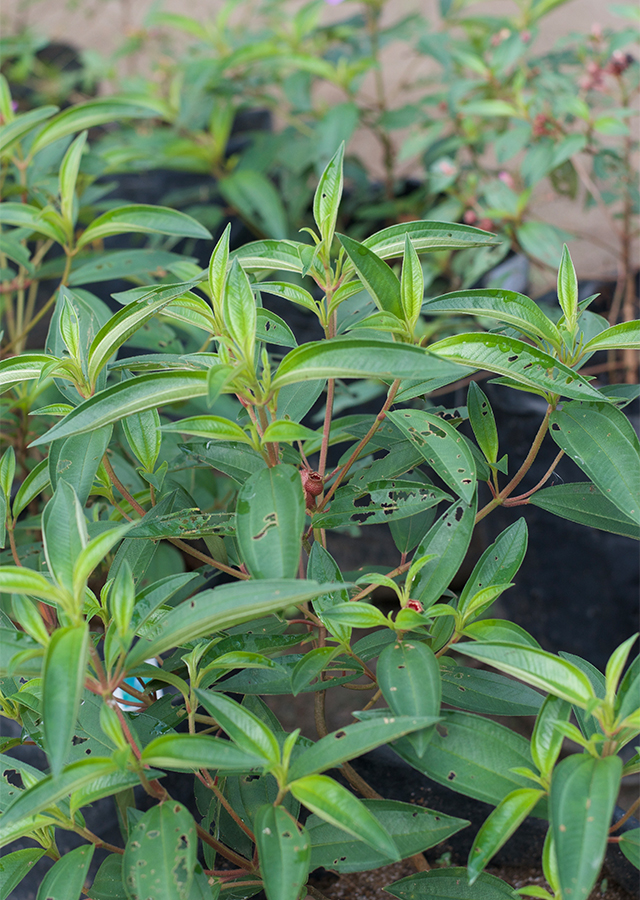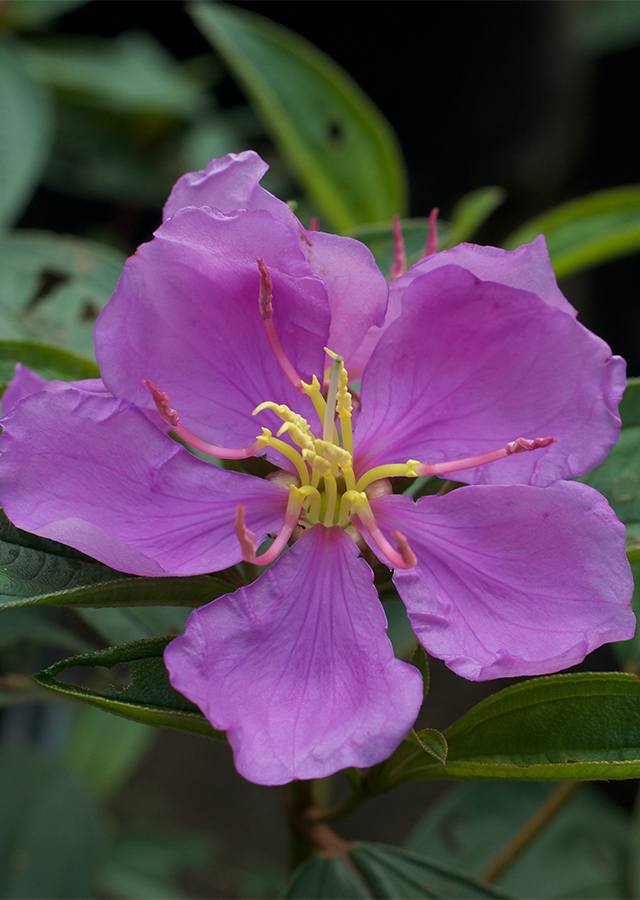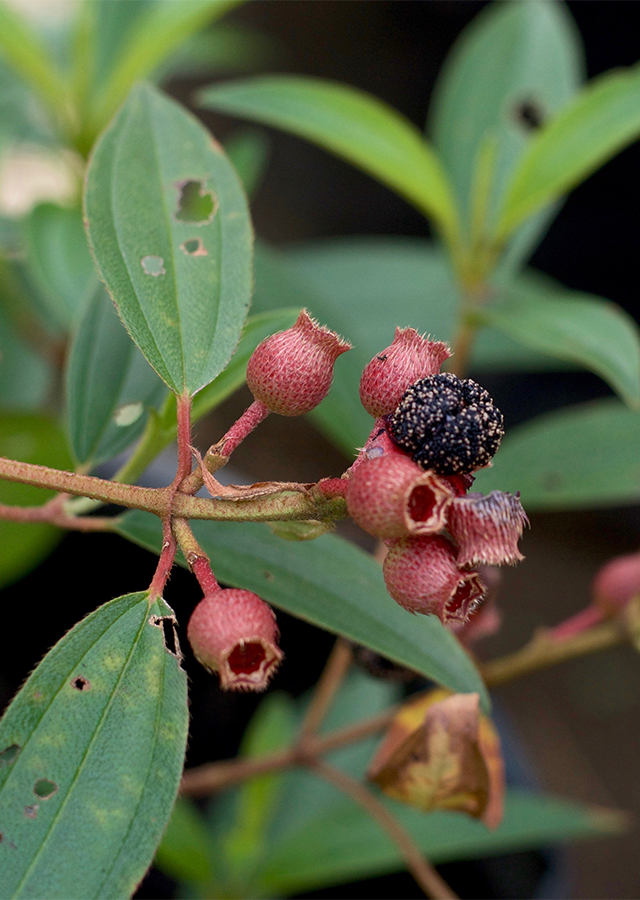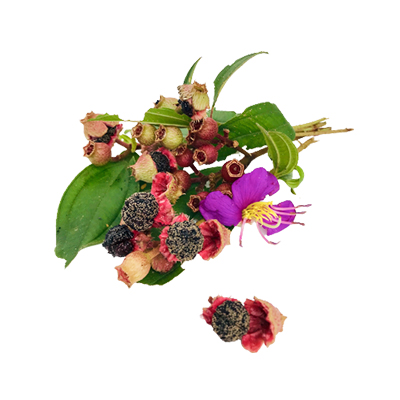Indian Rhododendron
Melastoma malabathricum L.
Melastomataceae
Location in our garden
Principal



Synonym
Melastoma malabathricum var. polyanthum Benth.
Melastoma polyanthum Blume
Habitus
Shrubs. Evergreen shrub or small tree usually growing up to 2.5 m tall
Part Used
Leaves
Seeds
Bark
Flowers
Fruit
Roots
Young Shoot
Growing Requirements
Full Sunshine
Need Shade
Habitat
Forest
Mountains
Shrublands
Grassland
Overview
Native to the Indian Ocean, China, Taiwan, south and Southeast Asia (including Singapore), Australia, and the South Pacific. The young shoots are eaten as a fresh or cooked vegetable, and the fleshy pulp of the fully ripe fruit is eaten fresh.
Vernacular Names
Harendong (Sundanese - Indonesia), Senggani, Kemanden (Javanese - Indonesia), Senduduk, Singapore rhododendron (Malaysia), Mua da hung, Mua se (Vietnamese), Khlongkhleng khee nok (Thailand), Ye mu dan (Chinese), Shapti (India), Malatungaw (Tagalog-Philippines).
Agroecology
It grows in open places, along the edge of forests, disturbed grounds, roadsides, thickets and river banks. A plant of hot, wet, tropical lowlands. Prefers an open, well-drained, fertile, humus-rich soil. This plant can be a serious weed in pastures, pineapple and other crops on peat soils. It is also a serious weed in oil palm, rubber and coconut plantations.
Morphology
- Stems - 4-sided to subterete, generally bristly, covered with small rough scales, and reddish
- Leaves - opposite, elliptic to lanceolate, 5-20 x 1.5-7.0 cm, acute or shortly acuminate at the apex, acute or rounded at the base, 5-nerved, with short appressed hairs on both surfaces, petioles 0.4-1.8 cm long.
- Flowers - pink to purple, compact or lose cymes of 3-7 flowers, terminal or in the upper leaf axils. Flowering and fruiting throughout the year.
- Fruits - urceolate-globular, 6–15 × 6–12 mm, succulent, densely squamose strigose
- Seeds - dimorphic (with or without embryos). Fertile seeds are folded or spiral, triangular to D-shaped in outline, 0.45–0.8 mm long, 0.35-0.6 mm wide, 0.17–0.3 mm thick, with light yellow or pale to dark cream-colored testa. Seeds without embryo 0.3–0.5 mm long, 0.2-0.3 mm wide, 0.2 mm thick, appear collapsed, dented, or wrinkled and with completely black or reddish-black testa.
Cultivation
- By seeds - best sown fresh in a nursery seedbed, or in containers because of the small size of the seed. Germination is best in either full sun or in light shade.
- Seed trials gave 65% germination within 10 - 15 days and up to 80% germination within 30 days
Chemical Constituents
Alkaloids, flavonoids, saponin, tannin, triterpenoids, steroids, phenolic, ellagic acid, anthocyanin, nobotannin β, Flavan-3-ols, Anthocyanins, Glycosides
Traditional Medicinal Uses
- All plant parts are traditionally used for the treatment of any ailment, such as diarrhea, puerperal infection, dysentery, leucorrhoea, wound healing, postpartum treatment, fractures, disorders digestive tract, anti-flatulent, diabetes mellitus, and hemorrhoids.
- In Thailand, this plant is used to plant used to treat toothache disease and dysentery
- The decoction of roots and leaves or roots alone is also traditionally used to tone up the uterus after childbirth in order to strengthen the womb and accelerate wound healing. Other than that, women also use this herb for excessive menstrual bleeding and cramps, to relieve postmenstrual syndrome, stomach ache, and white discharge, and to enhance fertility
Part Used
Reference Sources
- Joffry, S.M., Yob, N.J., Rofiee, M.S., Affandi, R.M.M., Suhaili, Z., Othman, F., Akim, A.M., Desa, M.N.M., and Zakaria, Z.A. 2012. Melastoma malabathricum (L.) Smith Ethnomedicinal Uses, Chemical Constituents, and Pharmacological Properties: A Review. Evidence-Based Complementary and Alternative Medicine, 258434, 48 pages.
- Kornkanok, T., Chalobol, W., Kaweesin, K., Treetip, S., and Chusie, T. 2015. Ethnomedicinal plants used for digestive system disorders by the Karen of northern Thailand. Journal of Ethnobiology and Ethnomedicine. 11(27).
- Sari, N.M., Kuspradini, H., Amirta, R. and Kusuma, I.W. 2018. Antioxidant activity of an invasive plant, Melastoma malabathricum and its potential as an herbal tea product. IOP Conf. Series: Earth and Environmental Science, 144.
- Susanti, D. Sirat, H.M., Ahmad, F., Ali, R,M., Aimi, N., and Kitajima, M. 2008. Antioxidant and cytotoxic flavonoids from the flowers of Melastoma malabathricum L. Food Chemistry, 103(3): 710-716.



